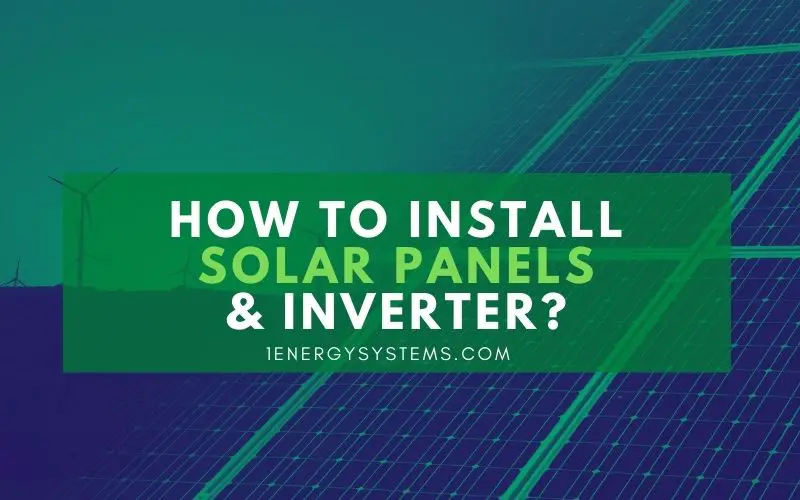Since you are already here, you probably know about the benefits of going solar. And, you must have compiled information on different types of solar panels and the components of a solar panel system.
In case you would like to read up more on the topic, you will find more resources here.
This article focuses on the installation of solar panels and inverter. You will find here a solar panel installation guide that tells you how to install solar panels step by step. The solar panel installation diagrams provided here will help you better understand the concept and follow the instructions.
Table of Contents
A Short Intro on Solar Energy
Planet Earth is very rich in energy resources. Some are non-renewable resources like oil, coal, natural gas, and nuclear energy. Renewable energy resources include solar, wind, biomass, hydropower, and geothermal energy.
We are fast running out of non-renewable energy resources, especially fossil fuels (oil, coal, and natural gas). Much research and technological advances have been made in the renewable energy sector.
Solar energy is the most popular among renewable energy resources for its ease of availability and free of cost. We can harness solar energy from the heat and light received from the Sun. This is either directly used as heat energy using solar thermal technology or it is converted into electricity using photovoltaic (PV) systems.
As the Sun is available in most parts of the world during the daytime, solar energy generation is possible during the daytime. However, as night falls, the unavailability of the Sun creates issues for those who want to depend on solar energy completely. This is where installing a battery backup will help. It stores the electricity generated during the daytime and meets your night time energy needs.
Now, let’s move on to the solar panel system and its various components.
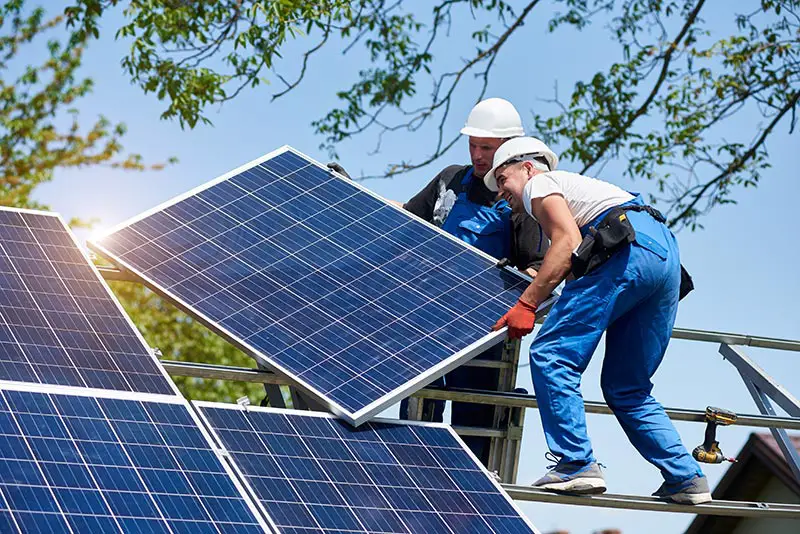
How to find the right solar panel system for your home?
One of the first things for you to decide is the size of the solar panel system. It should neither be too big nor too small. If it is too big, you will end up installing a system that can generate electricity way beyond your need. You will be paying for something you are not going to use.
On the other hand, if the solar panel system is too small, it cannot meet your energy needs by itself. You will have to rely on other energy sources to bridge the gap. Like grid power, wind power, or geothermal, depending on your location and availability.
Let’s discuss how to calculate the size of your home solar energy system. For this, you first need to know your consumption.
How to calculate your average energy consumption?
You can calculate your average monthly energy consumption using two methods.
From your past electricity bills:
Collect your electricity bills for the past year. You should be able to figure out how much energy you have consumed in each billing period. Add all of them up and find the average for a month. This is simple enough as long as you have access to your old bills.
Manual calculation:
Note down all the electrical appliances installed in your home and figure out their electrical power or wattage. You also need to know approximately how long you will be using each one of these appliances every day.
Multiplying the wattage of each piece of electrical equipment by the number of hours of expected use will give you the energy consumption of the equipment per day. Multiply by 30 and you get it for the month.
Adding the energy consumption of all appliances will give your total monthly energy consumption.
Once you have your monthly load ready, it is time to think about the size of the solar energy system.
What size solar energy system should you install?
Now, you know your monthly energy consumption. Add 30% extra to it to meet your extra requirements in the future and to account for the lost energy during conversion from DC to AC and transmission. This will give you the load of the system you need to install to meet your energy needs.
Next, let’s move on to the site to install solar panels. How much area you need for solar panels depends on the hours and intensity of sunshine received and the rating of the solar panels.
You can calculate the number of panels by dividing the total energy consumption by the capacity of a PV panel. From the area or dimensions of each panel and the number of panels you now arrived at, you can calculate the area required to install the PV panels.
How to calculate the size of the inverter and battery?
Size of the inverter:
An inverter in a solar energy system should be 25-30% bigger than the overall load of all appliances. In case you have appliances that require high torque such as a motor, inverter capacity needs to be 3 times more than normal.
Size of the backup battery:
This is influenced by numerous factors including the actual load calculated earlier. You also need to decide on the voltage of the battery system. It starts at 12V and goes on to 24V, 48V, and higher. Choosing a battery system of higher voltage (48V or higher) is advisable as the system loss will be less. Based on your choice, the backup battery size will vary.
Other factors influencing the size of the backup battery are its efficiency, depth of discharge, and the hours of backup required. A point to remember here is that the life of the battery is adversely affected if it is allowed to discharge more than 50%. If you will be relying on the battery for a longer duration, opt for one with sufficient capacity.
Battery backup is calculated by multiplying the actual load with days of autonomy and divided by battery system voltage, depth of discharge, and efficiency of the battery. The calculated battery backup system capacity in Amp-hours (Ah) is further divided by the Amp-hours (Ah) of a single battery to find the total no of batteries required for your system.
How to install a solar energy system?
The installation of the solar energy system includes solar panel installation, electrical wiring, connecting it up with the inverter, backup battery, and other components of the system. It also includes linking it up with the electrical box at home so that the solar power reaches all appliances.
Let’s begin from the beginning.
Solar panel installation
This involves installing the mountings for the PV modules, fixing the PV panels, and connecting them all up with electrical wiring.
Installing the PV module mountings
PV module mountings can be fixed in many ways as shown in the figure below. Some of the factors to consider while making the choice are:
- Location of the home
- Direction and inclination of the roof
- Angle of incidence of sun rays
- Presence of obstructions like trees and buildings
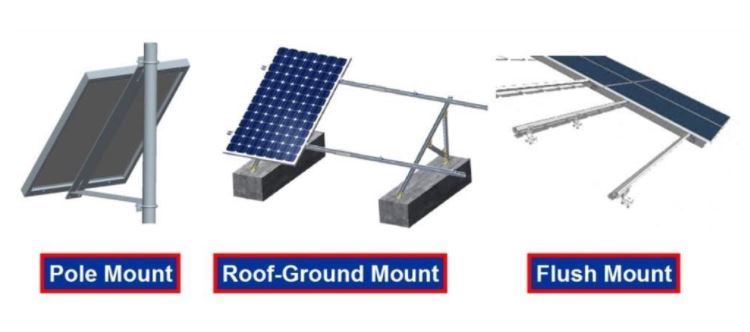
Orientation:
The PV modules must be exposed to sunlight for the maximum duration. In the case of fixed mountings, more care should be taken to decide the position, direction, and angle of tilt of the mountings. However, if tracking is installed, the solar panels can adjust the tilt to ensure maximum exposure to the Sun.
Typically, solar panels are installed facing north in the southern hemisphere and facing south in the northern hemisphere.
The angle of tilt:
When the solar panels receive direct sunlight, they generate the maximum electricity. This means if you are living along the equator, you should place the PV panels horizontally to get maximum exposure to sunlight.
However, as you move away from the equator, on either side, you need to keep the mountings titled at the exact angle to ensure that the PV panels receive maximum solar radiation. The ideal angle of tilt is equal to the latitude of your location.
In case you are opting for movable mountings, you can raise the efficiency of the system by increasing the tilt by 15o during the winter months and reducing it by 15o during the summertime.
Refer to the figure below to understand more about orientation and tilt angle.
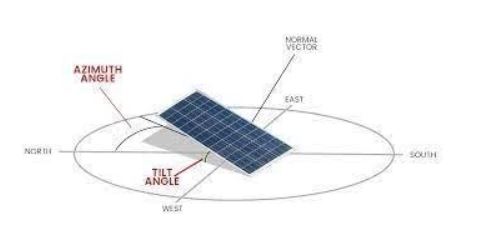
Once you have decided on the type of mount, orientation, and tilt angle, fix the mountings securely in the assigned place.
Fixing the PV panel
Now it is time to mount a solar panel. Place solar modules on mountings and tighten the nuts and bolts to fasten them securely. It is necessary to make sure that PV modules are firmly mounted and can withstand strong winds. Otherwise, there are chances of the panels getting dislodged or even flying off leading to damage and destruction.
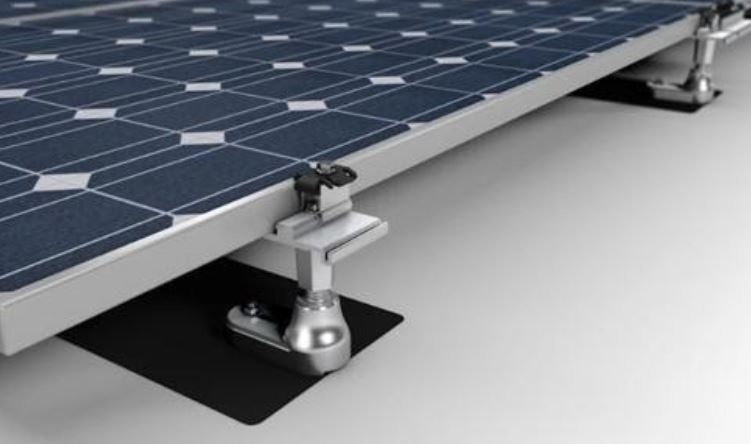
Electrical wiring
MC4 connectors are used for wiring a solar system to avoid sparking and rusting of connections. The connection of the PV module in a string can be made in two different ways.
Series Connection:
When a higher voltage output is required, the solar modules are connected in series. In a series connection, the voltage gets added up while the current remains the same.
Connecting in series means the negative terminal of a solar module is connected with the positive terminal of the second solar module and the negative terminal of the second module is connected with the positive terminal of the third module. This is continued until the last module as shown in the figure below:
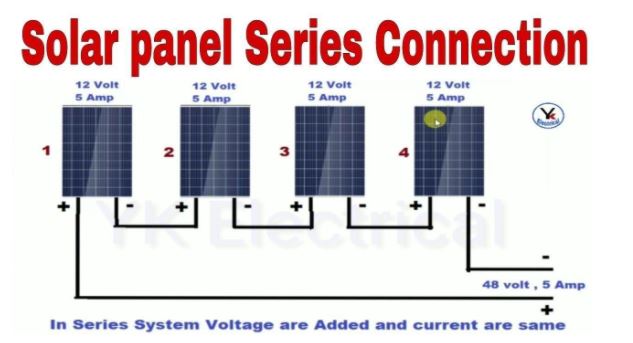
Parallel Connection:
When a higher current output is required, solar panels are connected in parallel. In a parallel connection, the current gets added up while the voltage remains the same.
Connecting in parallel means the negative terminals of the solar modules are connected together and the positive terminals are connected separately as shown in the figure below:
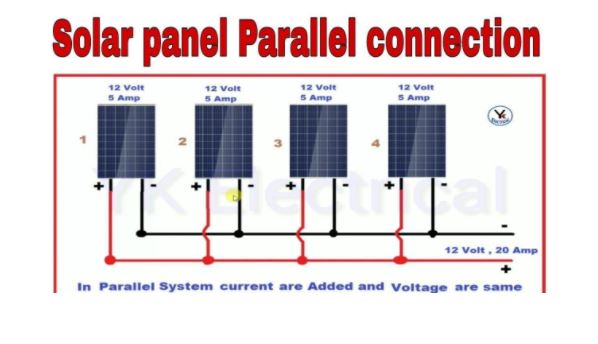
Note: Before doing electrical wiring, check the nameplate of solar PV modules. This will give you information about the maximum current and voltage of a single string. You can also find out more information about the number of panels required in a string and the number of strings in an array.
Make sure that the voltage of a string does not exceed the specified voltage of the inverter/charge controller. A sample nameplate of a solar module is attached below for reference. Apart from the inverter or charge controller voltage rating, the solar modules have their own maximum system voltage rating. So, one must consider both ratings before deciding the number of panels to be included in a single string.
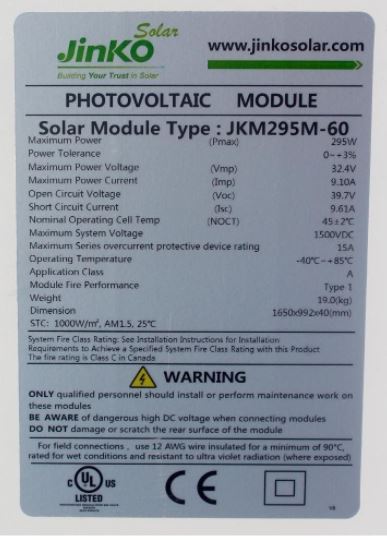
Connecting solar module with inverter
A solar inverter is a vital component of a solar energy system. The solar energy generated by the solar module is Direct Current (DC). This is not suitable for use in most home appliances. Most electrical appliances require Alternating Current (AC). An inverter converts the DC power generated by the solar module into AC power.
PV modules connected in series or parallel connections are further connected to the inverter through a string. A string comprises two wires, positive and negative. The negative wire from the string is connected to the negative terminal of the inverter and the positive wire from the solar module string is connected to the positive terminal of the inverter.
A DC breaker is also introduced in the string to ensure the safety of the system from accidental current variations. As a safety precaution against electrical surges, a surge arrestor is installed and grounding needs to be done.
Connecting the backup battery
The battery is not an essential component of a solar energy system. You may include a battery bank to ensure 24 hours solar power for your home. As mentioned earlier, the Sun is not available during the night hours and the system cannot generate electricity during these hours.
A battery can be used to store the excess power generated during the day for use during the night time. The output load of the inverter is connected with a 120 VAC load of the battery using a parallel connection.
DC power coming from the solar module is supplied to the inverter. This is used to charge the battery bank as well as converted into AC for use in appliances. When solar power is not available, the stored energy in the battery bank is used to power the system through the inverter.
Inverter connections have been explained in the figure below.
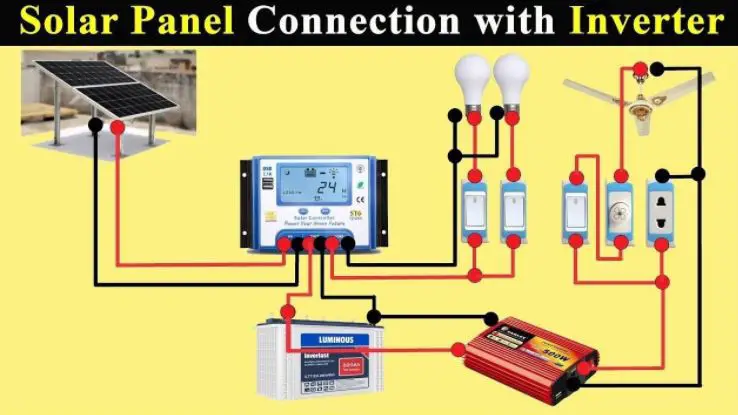
The solar power system can provide both AC and DC loads. AC load comes from the inverter, while the DC load comes directly from the battery bank with the help of a converter. This arrangement can keep the voltage of the entire system in check and prevent accidental spikes.
Before installing a home solar power system
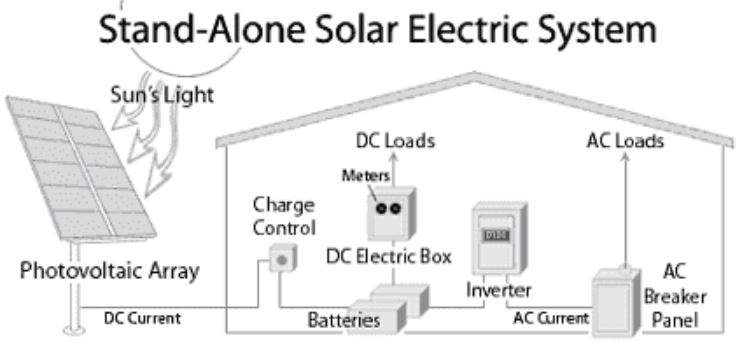
Points to remember
With many homeowners opting to switch to solar power partially or fully, the demand has grown exponentially in the last decade or two. The incredible advances in solar technology have made solar power more accessible and lucrative.
However, you need to consider many things before taking the plunge. Purchase and installation of a solar system are quite different from buying any other electrical equipment.
Here is a list of points to consider before you decide to go solar. This can also help you decide the type, size, and other aspects of the solar power system.
- Does your home have a flat roof or is it sloped?
- How strong is the roof? Is it possible to install mountings on the roof securely?
- Can the roof bear the weight of the Solar module and the mountings?
- Is the roof surface even? Or does it come in different shapes and sizes?
- Which direction do the roof slopes face? Is it well-exposed to sunlight?
- Does your roof drain well? Where does the rainwater go?
- Is your location affected by severe weather conditions like hails, storms, hurricanes, and lightning? Is it prone to natural disasters like earthquakes, landslides, and sinkholes?
- Does your roof need repair?
- Are you planning to go off the grid? If not, how are you planning the grid connection?
- Is it to bridge the deficit or is it for net metering arrangement?
- Do you need to seek permission for the arrangement? What is the fee? How does the credit system work? Will you be paid the same rate for electricity fed into the grid as for the electricity you use from the grid?
- Do you plan to shop around for the solar power system? Have you done your research and compared quotes, customer reviews, and other details with contractors?
- Does your contractor come with verifiable recommendations?
- How did you pick the solar power system? Did you choose the cheapest one?
- Have you done due diligence on warranties?
- Have you considered insuring the solar power system?
- Are you aware of the discounts and rebates offered for the installation of the solar power system?
- Are you planning to install the system by yourself? If yes, do you think you have gathered enough information on the topic? Are you ready to handle it if things go wrong?
- How much information do you have about maintaining the solar power system? Have you considered the cost involved?
Going solar is the trend nowadays. But before you jump on the solar bandwagon, you need to think about it from all possible angles to avoid trouble and regret later on. As the solar system is a high investment purchase, it would be advisable to do your own research and due diligence.
For example, if your roof is not in good condition, it makes financial sense to repair it before installing the system. Or later on, you will have to spend a considerable amount to remove the solar panels to carry out the repairs.
If water is not draining well on your roof, it can cause short-circuiting of the system. If net metering is not available in your area, it makes sense to install a system that can generate just enough power for your needs. Again, if the credit arrangement is not in your favor, it doesn’t serve your purpose to opt for net metering.
Bottom line
Solar energy has the potential to meet the energy demands of the entire world. All we need is the infrastructure to capture the radiation from the Sun.
However, buying a solar power system is not as simple as buying a washing machine or a refrigerator. As explained here you need to consider multiple aspects before making the decision.
Before you go solar shopping, arm yourself with all relevant information so that you are not taken in by the smooth-talking salesperson or too-good-to-be-true offers. Gather sufficient knowledge on the topic to make a well-informed decision.
Recommended Reading:
- How much does it cost to install solar panels
- How Do Solar Panels Work
- Why are Solar Panels So Expensive
- The Pros and Cons of Solar Energy
- Difference Between a Solar Cell and Solar Panel
- How to Protect Solar Panels from Hail?
- Common Problems with Solar Panels on Roofs
- How to Get Rid of Pigeons Under Solar Panels?
- Solar Panel Maintenance Checklist
- Solar Farm Land Requirements
- Questions to Ask Solar Company Before Signing a Contract
- Backyard Solar Panel Pergola & Patio Covers

